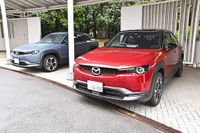In a bid to achieve decarbonization, Mazda is adopting a 'multi-solution' strategy that encompasses everything from traditional internal combustion engines to plug-in hybrid vehicles (PHV) and electric vehicles (EV). This approach is exemplified by the Mazda MX-30, a compact SUV that embodies the company’s innovative spirit and commitment to new technologies.
Launched in 2021, the MX-30 marked Mazda's first venture into the electric vehicle market. In 2023, the company revived its iconic rotary engine for use in the PHV version of the MX-30, further showcasing its dedication to innovation. However, despite these advancements, the domestic sales of the MX-30 have been disappointing, culminating in the cessation of production for the EV model at the end of March 2025.
The MX-30 serves as a testing ground for Mazda's challenging spirit, integrating new technologies early in its development. Although it shares a platform with the Mazda3 and CX-30, the MX-30 features distinctive elements such as 'freestyle doors,' a compact front grille, and a cork-made interior inspired by Mazda's predecessor, Toyo Cork Kogyo. Notably, the three main developers behind the MX-30 were women, adding a unique aspect to its development story.
Initially, the MX-30's lineup in Japan included both mild hybrid and EV powertrains. The EV was launched in Japan in 2021 and subsequently introduced to European and US markets. In Europe, the model aimed to meet the stricter Corporate Average Fuel Economy (CAFE) regulations that were strengthened in 2020. However, the battery capacity of the MX-30 is relatively small at 35.5 kWh, resulting in a modest range of 256 kilometers (WLTC mode) per charge.
In 2023, the introduction of the PHV 'rotary EV' version of the MX-30 reignited interest in the model. This marked the return of the rotary engine for the first time in approximately 11 years since the RX-8 sports car, although it is utilized solely for power generation in this context. While the MX-30 is proactive in incorporating new technologies, its sales performance has been lackluster.
In the fiscal year 2024, domestic sales of the MX-30 plummeted to just 1,016 units, reflecting a staggering 49.5% decrease compared to the previous year. This figure is less than one-tenth of the sales of the CX-30, which totaled 14,360 units. Several factors contribute to this disappointing performance, including the MX-30's unique 'freestyle door' design and a deliberate reduction of the 'Mazda-ness' that characterizes other models in the lineup.
Another significant challenge lies in the domestic PHV market, which has proven difficult. While PHVs combine the benefits of charging and refueling and offer a longer total range than EVs, they accounted for only 1.7% of domestic sales as of March 2025. This limited market share can be attributed to the prevalence of apartment buildings in Japan, a lack of public charging infrastructure, high vehicle prices, and a limited selection of models, all of which have led to a continued preference for hybrid vehicles (HV) among consumers.
The MX-30 PHV also faces inherent challenges. Although the rotary EV technology is intriguing, it produces a distinctive low-frequency noise and vibration during power generation. While rotary enthusiasts may appreciate these characteristics, they fall short of the quietness and comfort that are hallmarks of EVs, indicating room for improvement in the PHV segment.
Moreover, the selling price of the MX-30 is relatively high, starting at 4,356,000 yen (including consumption tax) in Japan. Although the government offers a subsidy of 570,000 yen, the overall performance—including a 125 kW and 260 Nm motor and a fuel consumption of 15.4 km/liter (WLTC mode) during hybrid driving—remains costly. The battery's expense significantly contributes to the vehicle's high price, and Mazda faces unique challenges in meeting emissions regulations for rotary engines in both the US and Europe.
Despite these sales struggles, Mazda is committed to leveraging the insights gained from the MX-30 to inform the development of next-generation vehicles. The company is developing a two-rotor power generation system for PHVs that aims to minimize noise and enhance quietness. This compact unit's characteristics may also be applied to the upcoming 'Iconic SP' sports car.
Looking ahead, Mazda plans to introduce EVs using a dedicated platform by 2027. They aim to reduce development efforts by 50% through the creation of a temperature management system that will influence range and battery life, utilizing their expertise in model-based development and artificial intelligence (AI). The knowledge gained from the MX-30 EV model will play a crucial role in these simulations.
The current landscape surrounding electric vehicles is increasingly complex. In European and US markets, hybrid vehicles are gaining market share as the adoption of EVs slows, while plug-in hybrids are becoming more popular in China. Additionally, the regulatory environment is shifting, with the Trump administration in the US contemplating revisions to environmental policies, and the UK allowing hybrid vehicle sales until 2035, creating uncertainty in regulatory trends.
Amid these challenges, Mazda's multi-solution strategy aims to balance decarbonization and corporate growth by offering various powertrains and adapting to market conditions. Although the MX-30 may not be a commercial hit, it plays a vital role in enhancing the competitiveness of Mazda's technology portfolio and establishing a distinct identity for the brand in the electric vehicle era.




